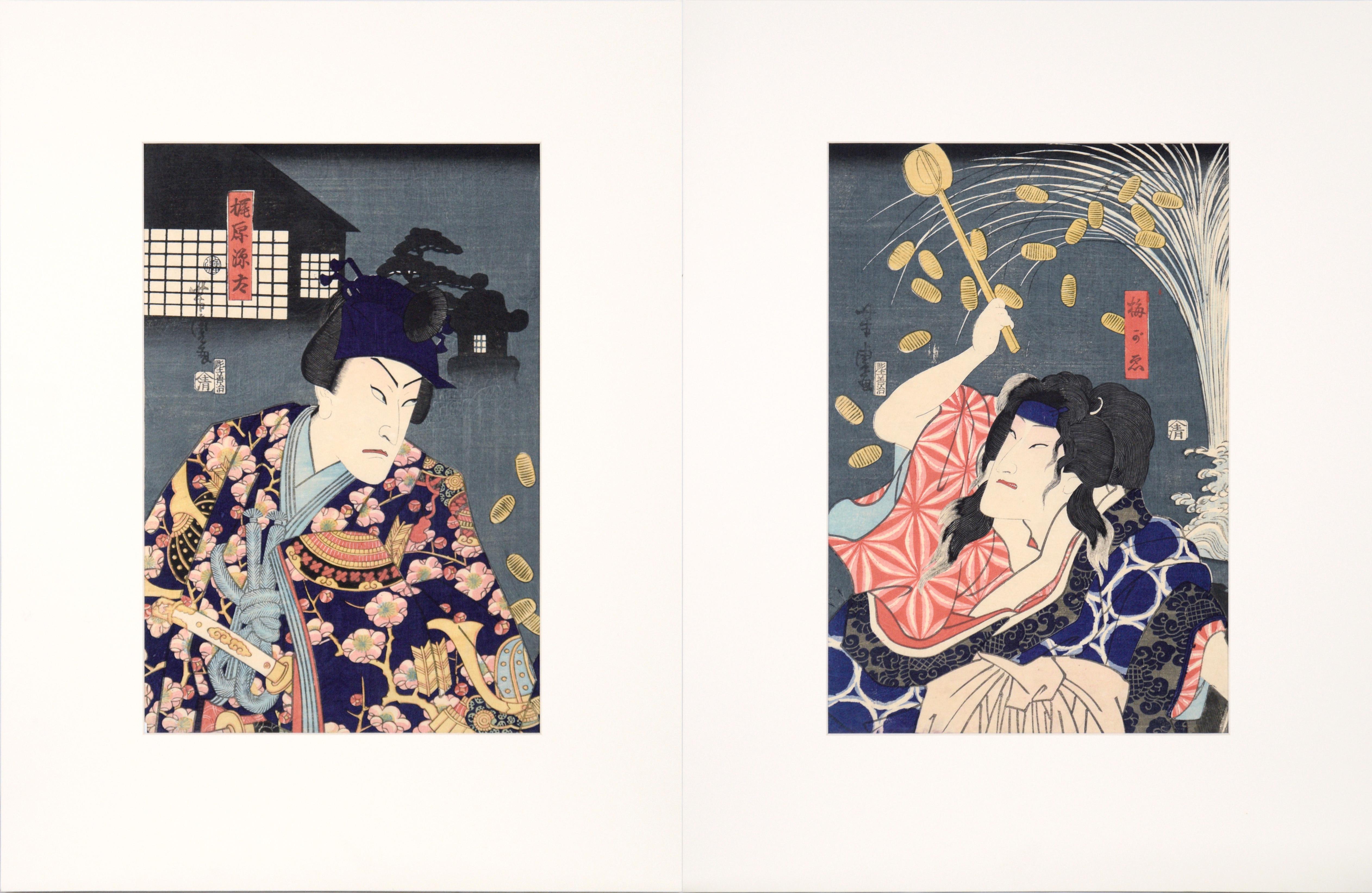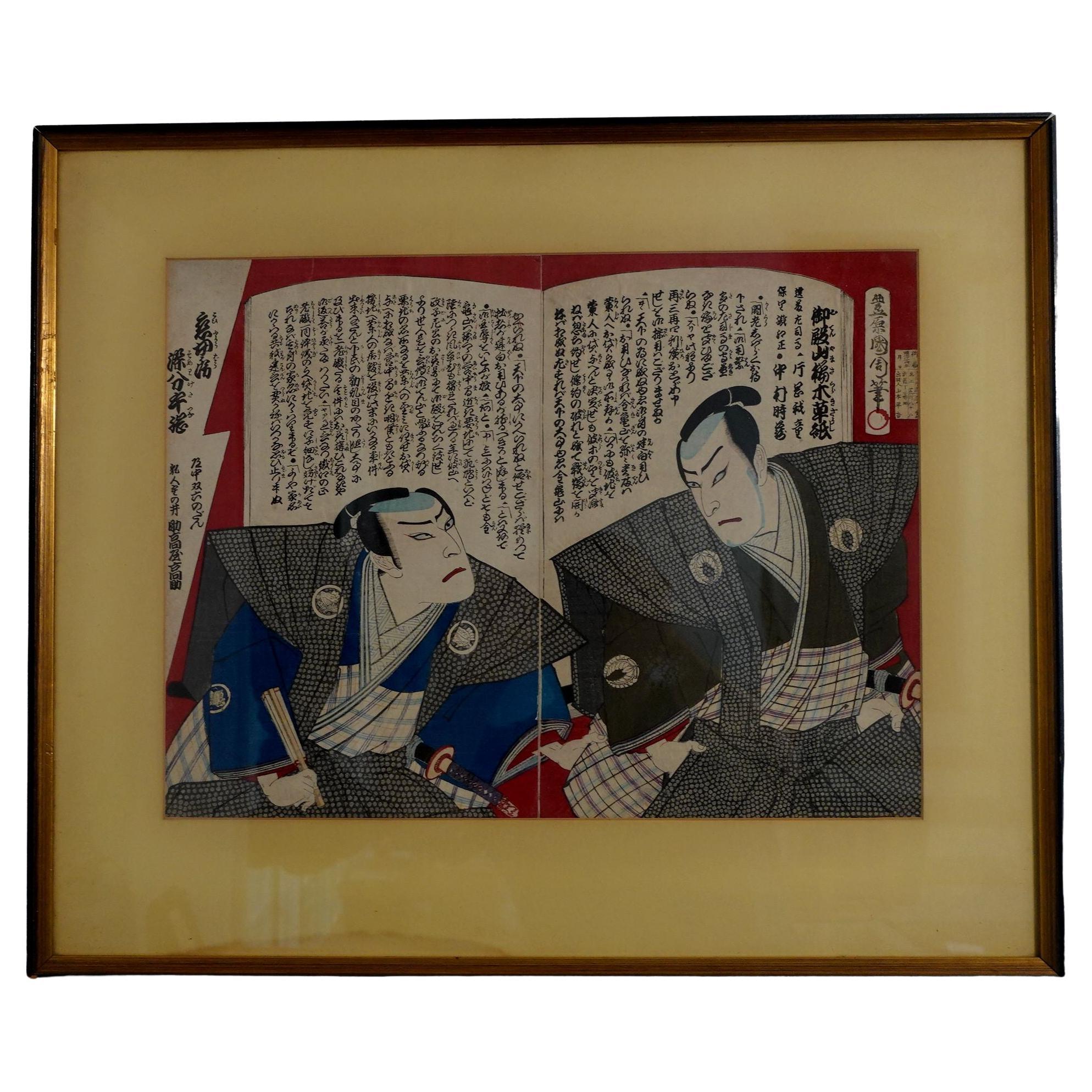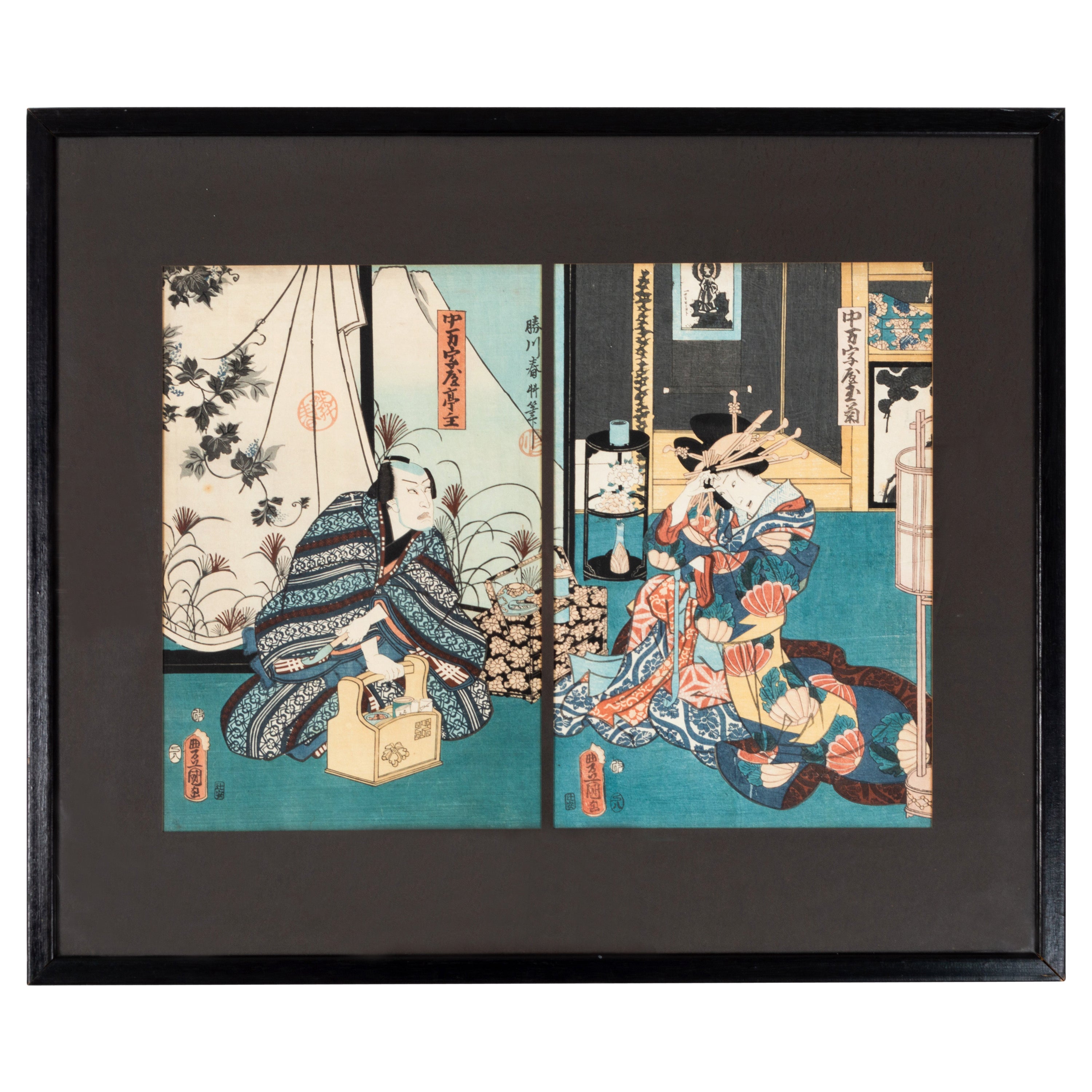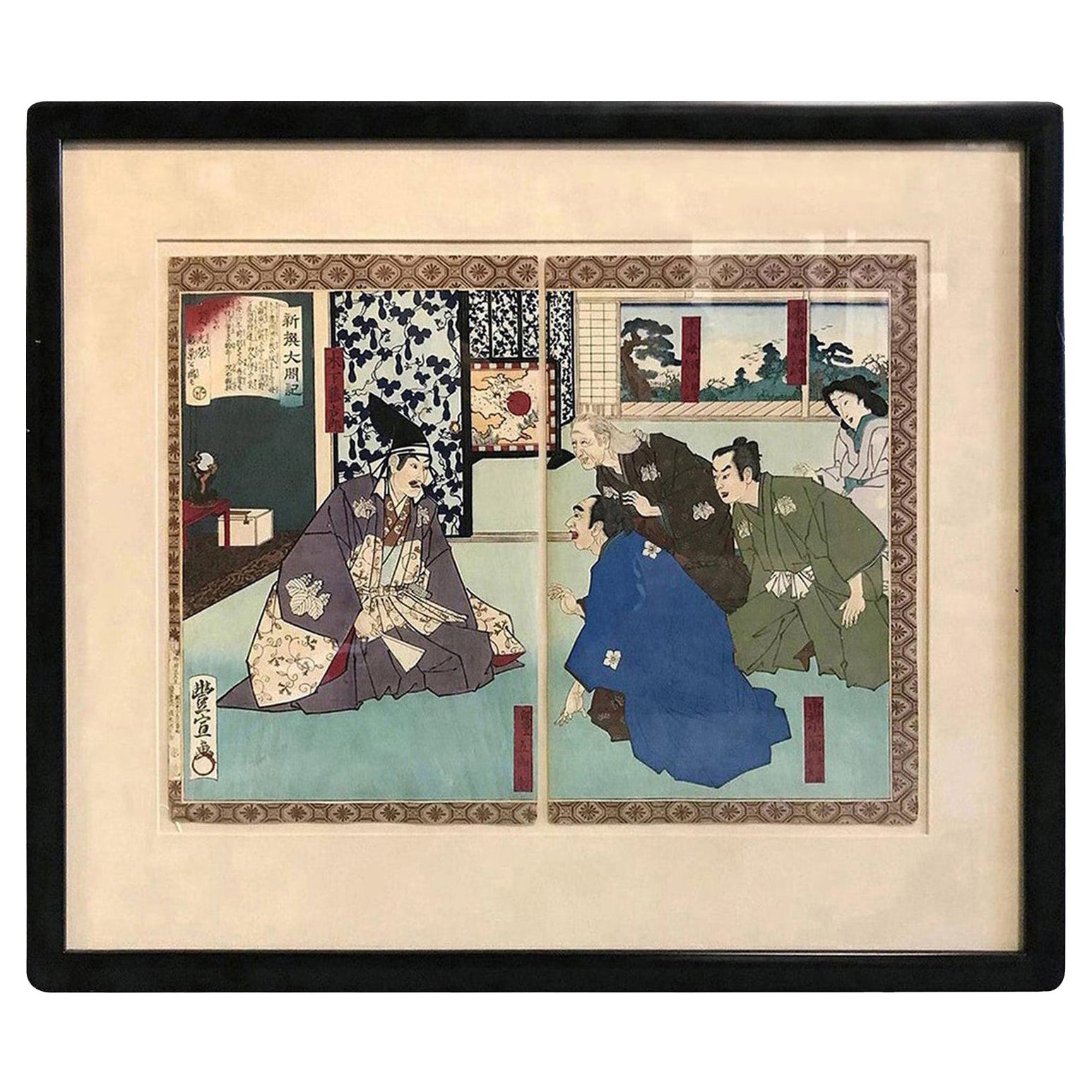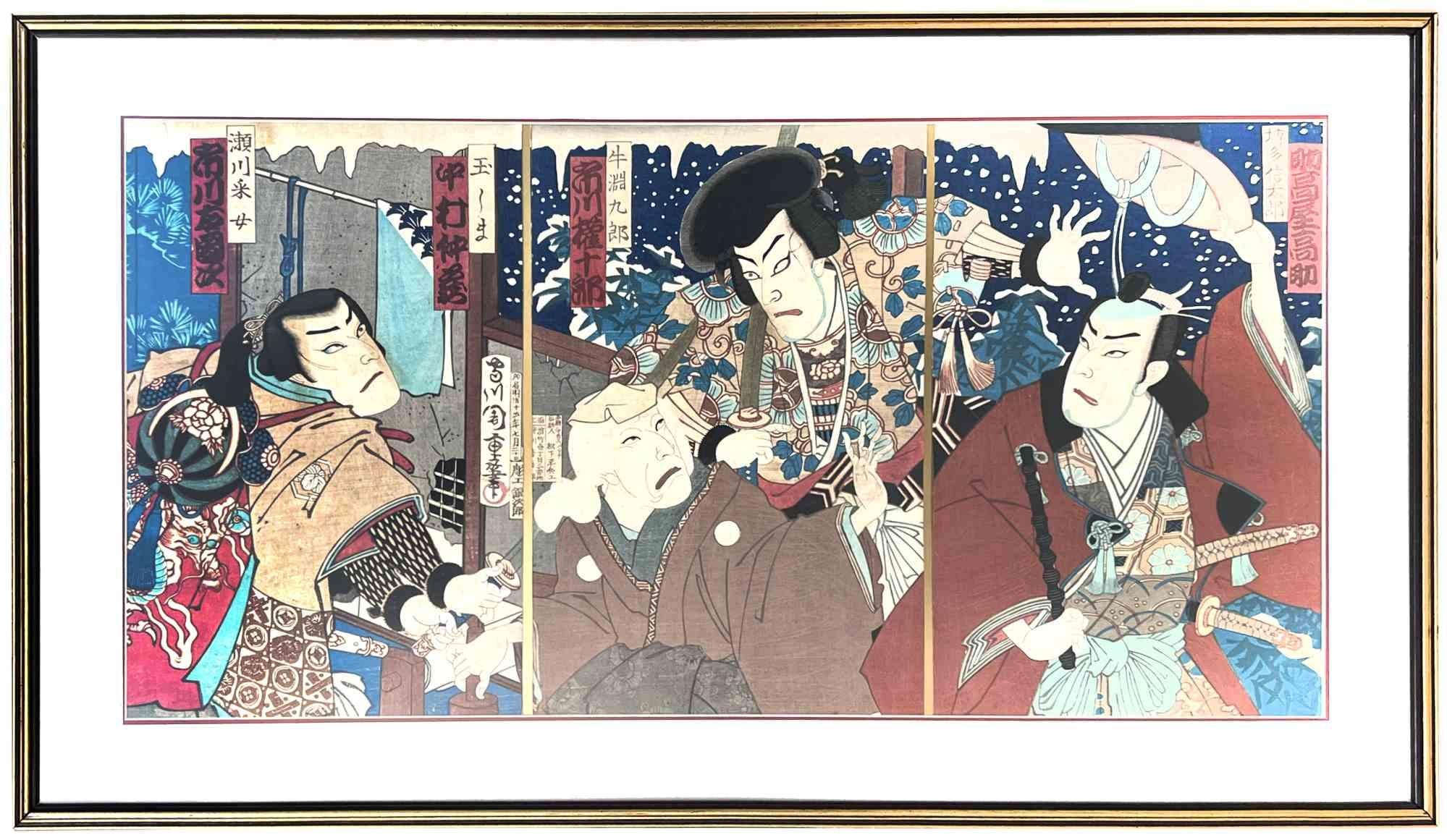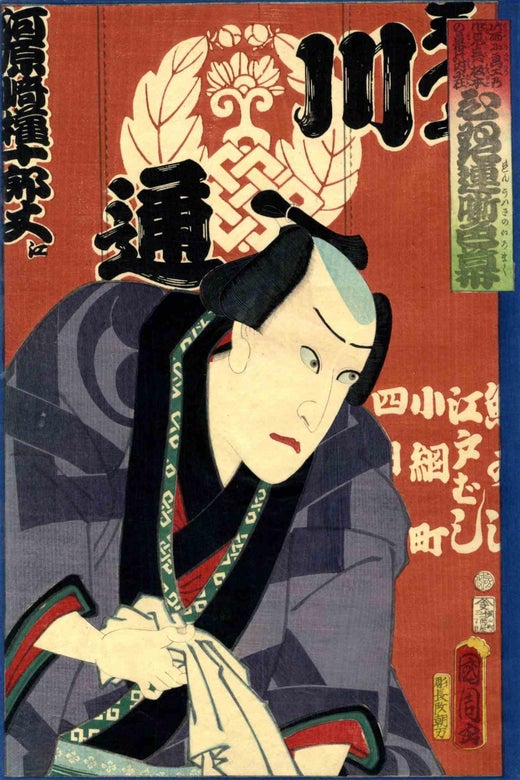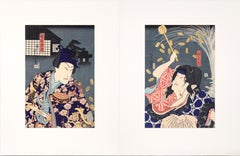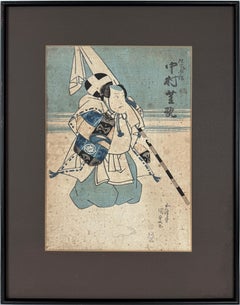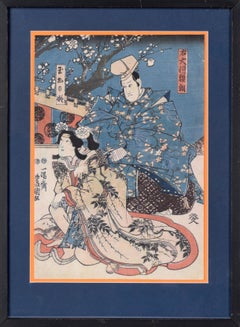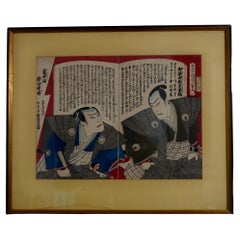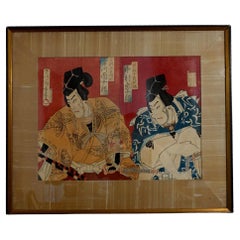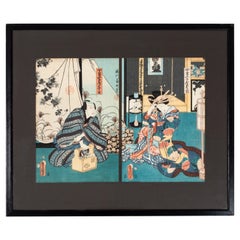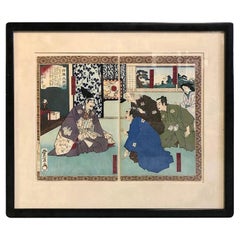Items Similar to Kabuki Actor Diptych, Late 19th Century Figural Japanese Woodblock Prints (Pair)
Want more images or videos?
Request additional images or videos from the seller
1 of 20
Kunichika ToyoharaKabuki Actor Diptych, Late 19th Century Figural Japanese Woodblock Prints (Pair)1870s
1870s
$700
$87520% Off
£531.95
£664.9420% Off
€612.24
€765.3020% Off
CA$1,001.74
CA$1,252.1720% Off
A$1,100.62
A$1,375.7820% Off
CHF 567.58
CHF 709.4820% Off
MX$13,186.55
MX$16,483.1820% Off
NOK 7,206.56
NOK 9,008.1920% Off
SEK 6,763.06
SEK 8,453.8220% Off
DKK 4,572.55
DKK 5,715.6920% Off
About the Item
Beautiful late 19th century Japanese woodblock print diptych of two kabuki actors by Kunichika Toyohara (Japanese, 1835-1900). This pair of prints is united by a continuous landscape, and the gaze of the figures as they look at one another.
Presented in cream mats, with black and red frames and plexiglass. Each frame measures 21.63"H x 17"W; Image size ~14.5"H x 10.5"W
The artist who became known as Toyohara Kunichika was born Ōshima Yasohachi on June 30, 1835, in the Kyōbashi district, a merchant and artisan area of Edo. It is believed that around age twelve Yasohachi began to study with Toyohara (Ichiōsai) Chikanobu (not to be confused with Kunichika’s student Toyohara Chikanobu). At the same time he designed actor portraits for battledores sold by a shop called Meirindo. His teacher gave him the name "Kazunobu". It may have been on the recommendation of Chikanobu that the boy was accepted the following year as an apprentice in the studio of Utagawa Kunisada, the leading and most prolific print maker of the mid-19th century. By 1854 the young artist had made his first confirmed signed print and had taken the name "Kunichika", a composite of the names of this two teachers, Kunisada and Chikanobu. His early work was derivative of the Utagawa style and some of his prints were outright copies (an accepted practice of the time). Kunichika's status continued to rise and he was commissioned to create several portraits of his teacher. When Kunisada died in 1865, his student was commissioned to design two memorial portraits. Kunichika died at his home in Honjo (an eastern suburb of Edo) on July 1, 1900 at the age of 65, due to a combination of poor health and bouts of heavy drinking brought on by the death at 39 of his daughter Hana while giving birth to his grandson, Yoshido Ito, some months previously. He was buried at the Shingon Buddhist sect temple of Honryuji in Imado, Asakusa.
- Creator:Kunichika Toyohara (1835 - 1900, Japanese)
- Creation Year:1870s
- Dimensions:Height: 21.63 in (54.95 cm)Width: 35 in (88.9 cm)Depth: 1 in (2.54 cm)
- Medium:
- Movement & Style:
- Period:
- Condition:Tonal ageing to paper, as expected for a piece of this age. Otherwise in very good condition. Minor scratches on plexiglass.
- Gallery Location:Soquel, CA
- Reference Number:Seller: JT-DBH6554A, JT-DBH6554B1stDibs: LU5428414832
Kunichika Toyohara
Kunichika Toyohara was born as Ōshima Yasohachi in 1835. Toyohara was one of the last Japanese Ukiyo-e painters. His first signed print is from 1852, but it was only in 1854 that he took the stage name Kunichika. Toyohara is best known for his prints of Kabuki actors, using the woodblock technique. He also painted beautiful women and for some special occasions, historical scenes. Toyohara was certainly a brilliant painter with unmistakable talent and dissipated life.
About the Seller
5.0
Platinum Seller
Premium sellers with a 4.7+ rating and 24-hour response times
Established in 1986
1stDibs seller since 2014
3,019 sales on 1stDibs
Typical response time: <1 hour
- ShippingRetrieving quote...Shipping from: Soquel, CA
- Return Policy
Authenticity Guarantee
In the unlikely event there’s an issue with an item’s authenticity, contact us within 1 year for a full refund. DetailsMoney-Back Guarantee
If your item is not as described, is damaged in transit, or does not arrive, contact us within 7 days for a full refund. Details24-Hour Cancellation
You have a 24-hour grace period in which to reconsider your purchase, with no questions asked.Vetted Professional Sellers
Our world-class sellers must adhere to strict standards for service and quality, maintaining the integrity of our listings.Price-Match Guarantee
If you find that a seller listed the same item for a lower price elsewhere, we’ll match it.Trusted Global Delivery
Our best-in-class carrier network provides specialized shipping options worldwide, including custom delivery.More From This Seller
View AllThe Samurai Genta Kajiwara - Japanese Woodblock Diptych in Ink on Paper
By Utagawa Yoshitora
Located in Soquel, CA
The Samurai Genta Kajiwara - Japanese Woodblock Diptych in Ink on Paper
Boldly colored woodblock by Utagawa Yoshitora (Japanese, active c.1840-1880)...
Category
1860s Edo Figurative Prints
Materials
Paper, Ink, Woodcut
$1,280 Sale Price
20% Off
Kabuki actor Nakamura Shikan II by Utagawa Kunisada Edo Japanese Woodblock Print
By Utagawa Kunisada (Toyokuni III)
Located in Soquel, CA
Kabuki actor Nakamura Shikan II by Utagawa Kunisada Japanese Woodblock Print
Wonderful portrait of Nakamura Shikan II, a prominent kabuki actor, in the role of Kisen Hoshi Toyokuni ...
Category
1820s Realist Figurative Prints
Materials
Printer's Ink, Rice Paper, Woodcut
Two Actors - Japanese Woodblock by Chikanobu Yoshu
By Toyohara Chikanobu
Located in Soquel, CA
Two Actors - Japanese Woodblock by Toyohara Chikanobu (豊原周延, 1838–1912), better known to his contemporaries as Yōshū Chikanobu (楊洲周延).
Colorful and expressive court scene. Two actors...
Category
1890s Edo Landscape Prints
Materials
Ink, Rice Paper, Woodcut
$700 Sale Price
20% Off
Kabuki Actor, Mid 19th Century Figurative Japanese Woodblock Print
By Utagawa Kunisada (Toyokuni III)
Located in Soquel, CA
Beautiful mid 19th century figural Japanese woodblock print of a kabuki actor in blue by Utagawa Toyokuni III (Kunisada) (Japanese, 1786-1864/5). Artist's chop is in the upper left corner of the piece. Presented in a cream mat, with a black and red frame and plexiglas. Image size ~13.5"H x 9.5"W
During his lifetime Kunisada Utagawa...
Category
1860s Edo Figurative Prints
Materials
Paper, Ink
"Pictures Of Noh" - 1922 Original Japanese Woodblock Print
Located in Soquel, CA
"Pictures Of Noh" - 1922 Original Japanese Woodblock Print
Original Japanese woodblock print by Tsukioka Kogyo (Japanese, 1869-1927...
Category
1920s Edo Figurative Prints
Materials
Ink, Rice Paper, Woodcut
"Juro Sukenari, Station #9: Oiso", Mid 19th Century Japanese Ukiyo-e Woodblock
By Utagawa Kunisada (Toyokuni III)
Located in Soquel, CA
Beautiful mid 19th century Japanese woodblock print of a samurai by Utagawa Toyokuni III (Kunisada) (Japanese, 1786-1864/5). This piece is from a series of "The 53 Stations of the To...
Category
1860s Edo Figurative Prints
Materials
Paper, Ink
You May Also Like
Japanese Diptych Woodblock by Toyohara Kunichika 豐原國周 Ric.J009
Located in Norton, MA
Japanese Diptych Woodblock by Toyohara Kunichika (1835-1900) 豐原國周
published in 1881 by Yamamoto Heikichi
Dimension: with frame, 24.75" x 20.75"
with...
Category
Antique 19th Century Japanese Prints
Materials
Paper
Japanese Diptych Woodblock by Morikawa Chikashige 守川周重 Ric.J010
Located in Norton, MA
Japanese Diptych Woodblock by Morikawa Chikashige 守川周重 (Active 1869 - 1882), published in 1881 by Morimoto Junzaburo, framed and glazed.
Dimension: wi...
Category
Antique Early 19th Century Japanese Prints
Materials
Paper
Framed Japanese 19th Century Diptych Woodblock Print Toyokuni II
Located in London, GB
Framed Japanese 19th Century Diptych Woodblock Print Toyokuni II
Toyokuni II (1786-1864)
"Courtesan Tamagiku and master of the Naka Manjiya House"
Pu...
Category
Antique 19th Century Japanese Prints
Materials
Paper
Utagawa Toyonobu Shinsen Taikoki Japanese Woodblock Diptych Print, 19th Century
By Toyonobu Utagawa
Located in Studio City, CA
A Classic image by renowned Japanese printmaker Utagawa Toyonobu from his newly selected history of Toyotomi Hideyoshi series.
A very good impres...
Category
Antique Late 19th Century Japanese Meiji Prints
Materials
Paper
Kabuki Scene- Woodcut by Toyohara Kunichika - The Late 19th Century
By Toyohara Kunichika
Located in Roma, IT
Kabuki Scene is a Japanese multi-colored woodcut tryptich realized around the end of the 19th century by Toyohara Kunichika (1835 - 1900).
Original woodcut on paper. The artwork is ...
Category
19th Century Modern Figurative Prints
Materials
Woodcut
Pair of Large Meiji Era Japanese Woodblock Prints
Located in London, GB
Pair of large Meiji Era Japanese woodblock prints
Japanese, Late 19th Century
Frames: height 42.5cm, width 78.5cm, depth 2cm
Prints: height 35cm, width 78.5cm
These excellent w...
Category
Antique Late 19th Century Japanese Meiji Prints
Materials
Paper
More Ways To Browse
Japanese Woodblock Prints
Framed 19th Century Prints
19th Century Japanese Woodblock
Japanese Prints Pair
Takashi Murakami Archival Pigment
Takeda Shingen
Tauromaquia Picasso
Tell Me Beautiful Untrue Things
Tomikichiro Tokuriki On Sale
Toulouse Lautrec Napoleon
Ulivieri Uliviero
Vadik Suljakov
Vintage 5 Amp
Vintage Heinz Beans
Vintage Yellow Stop Sign
Von Stuck Lucifer
W. L. Walton On Sale
Warhol Christmas Tree
